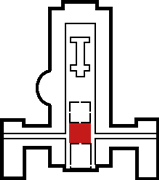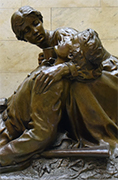Nurses Hall
(Second Floor)
 |
 |
Climbing the stairs at the end of Doric Hall, you will leave the 1798 Bulfinch Front and enter the 1895 Brigham addition to the State House. This small hall contains a Daniel Chester French bronze statue of the Massachusetts Civil War hero, William Francis Bartlett.
The next, larger room, built largely of Pavonazzo marble, is called Nurses' Hall because of the statue of an Army war nurse located on the right. Sculpted in 1914 by Bela Pratt, it was the first statue erected in honor of the women of the North after the Civil War.
Nurses' Hall also features several murals by Robert Reid depicting events crucial to the start of the American Revolution. Paul Revere's ride of April 19, 1775 is on the left, the Boston Tea Party is on the right. The central panel portrays the true beginning of the colonists' break with England.
Fiery orator James Otis is pictured arguing against the Writs of Assistance, which allowed British soldiers to enter private homes and shops in search of smuggled goods. Refusing payment from the Boston merchants who retained him, Otis presented his case in February 1761. Although he did not win the case, Otis was described by John Adams as "a flame of fire... then and there the child Independence was born".
Notable facts
- Major General William Francis Bartlett was a hero to both the North and the South. Named a general at the age of twenty-four, he was wounded four times and lost his left leg in the battle of Yorktown, but continued to lead his troops. After the war, he was asked by both Virginia and Massachusetts to run for office. He refused both offers, and died at the age of thirty-six.